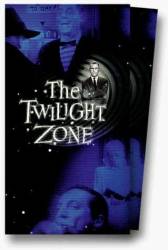Factual error: The lieutenant is wearing cavalry insignia, but he is in the infantry company.
Showdown with Rance McGrew - S3-E20
Factual error: Throughout this episode, the TV western supposedly being filmed lacks several essential elements. There are no clapboards to mark the scenes; the modern-day car is constantly in shot through the swinging doors; and the set is located inside the "real" saloon when it should be on a sound stage.
Factual error: Author Damon Knight was happy with Rod Serling's TV adaptation of his short story - except for the change that allowed the humans to translate the Kanamit language as though it were a code. Said Knight, "Without some sort of interplanetary Rosetta Stone, deciphering an unknown language would be impossible." (00:22:10)
Factual error: As well as the obvious problem with translating an unknown language as if it was a code, there is no chance that the word "serve" would have the same double meaning in English and Kanamit. It would be like the word "dope" and its French equivalent meaning "idiot" and "illegal drugs" in both languages.
The Thirty-Fathom Grave - S4-E2
Factual error: On the bulkhead of the ship's sickbay is a standard 12-hour civilian clock. It shouldn't be there. All clocks aboard U.S. Navy vessels show 24-hour military time. (00:31:20)
No Time Like the Past - S4-E10
Factual error: The U-boat has a spinning sonar mast. Subs in 1915 didn't have that.
Of Late I Think of Cliffordville - S4-E14
Factual error: Even though its supposed to be 1910, the banker's daughter plays a 1960's Steinway piano.
The Incredible World of Horace Ford - S4-E15
Factual error: In the opening scene, Horace painstakingly loads his six-shooter cap pistol with a six-cap round - then shoots his boss with it seven times. (00:00:40)
On Thursday We Leave For Home - S4-E16
Factual error: The colonists' planet has twin suns and, we're told, no night. We see the suns, side-by-side in the sky. But twin suns would not create perpetual day. Night/day is caused by the rotation of the planet on its axis, regardless the number of suns. In a binary star system, the two stars orbit each other around a central point in space. The planets would orbit around that central point too. In order for there to be no night, the planet would have to pass between the two stars, a process it would not survive. The gravitational forces of two opposing suns would tear the planet apart. (00:18:35)
Suggested correction: This assumes that all planets orbit along a Sun's equatorial plane, which they don't. In fact Earth's orbit is 7° off on either side of our Sun's equatorial plane. Also taking into account the tilt of their planet, it's likely that experience a similar phenomenon to that of Alaska, although for much longer, where their orbit and position don't allow their side of the planet to see darkness.
Factual error: When McNulty clicks his stopwatch the helicopter is shown frozen in flight but the blades are shown as a blur, they should be just as much in focus as the rest of the helicopter.
Probe 7 - Over and Out - S5-E9
Factual error: Cook draws his sun and planets in the sand, saying that it's "my galaxy." When Norda draws hers, he calls it another galaxy. Wrong. He's drawn a solar system, not a galaxy. (A galaxy is a collection of millions of solar systems.) The terms are in no way synonymous - there's a vast difference, and a trained astronaut would definitely know that. Their little ships can't possibly cross galactic voids (that would require tens of thousands of years, even at many times the speed of light), so Cook and Norda's planets are in different star systems in the same galaxy - this one. (00:16:30)
The 7th is Made Up of Phantoms - S5-E10
Factual error: Numerous references are made regarding George Custer being a general at the Battle of the Little Bighorn when, in fact, he was a lieutenant colonel.





